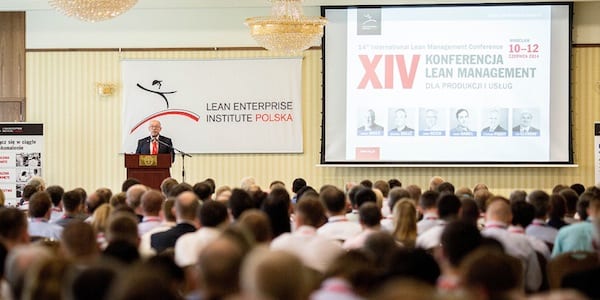
Fighting every single nugget of resistance
CASE STUDY – One year into its lean journey, this Lithuanian mining company is winning the hearts and minds of its people. Here, the management team reflects on how they are doing it.
Words: Gediminas Skvernys, CEO, Mindaugas Gudas, Deputy CEO, and Rytis Burkauskas, Senior Engineer, AB Dolomitas – Lithuania.
Dolomitas – a 180-people Lithuanian company that mines and processes dolomite from the Petrašiūnai-2 quarry – had been tracking a number of efficiency-related indicators for years, but neither systematically nor with a clear strategy in mind. In March 2018, we decided to embrace lean management to develop an end-to-end understanding of our processes and effect improvement across the entire value stream. Despite our efforts to allow each team to go at their own pace and tackle the problems they deemed most critical, resistance to change and engagement represented serious challenges for us in the first few months.
Until recently, for example, it was totally accepted within the company that our machine operators would also be in charge of repairing equipment. Since turning to lean thinking, however, we have separated these functions: these days, operators drive machines and service staff repair them. Convincing our people that this transition would result in better, more efficient work was difficult. They considered themselves entirely responsible for their machines, from driving them to fixing them. Many of them have worked for the company a long time and were used to their own way of doing things, so we couldn’t expect to come into work one morning and swiftly declare that from that moment on everybody would behave differently. Only when the atmosphere at work became more relaxed and the work less hectic did people start to buy in.

Changing mindset is difficult and it takes time, but when you finally get it people start wondering how they ever worked without a standard or not following a lean approach. What’s already become clear to us is that no transformation can happen without leadership engagement. First of all, we had to persuade ourselves and start believing in lean. How could we expect others to believe in it otherwise? Today, as managers, we are spending more time at the gemba, immersed in the process, and that’s what’s allowing change to take root and what’s motivating our people. We are trying to get better at communicating, we are listening more, and we are trying to improve working conditions for Dolomitas employees.
We have learned that leadership participation is a critical requirement. Words are not enough; people have to see us actively engaged in the improvement work. We can’t expect to give them an assignment and go home for the day! The hard work to foster motivation is starting to pay off and our family of lean believers is slowly growing. At the same time, it’s clear we have a long way to go (as you would expect after just one year since the introduction of lean ideas in the company). Our middle managers acknowledge they need to learn more about the lean philosophy, but at the same time some of them refer to improvement work as “lean homework”. Until we take that word out of their vocabulary, we won’t be able to say we have achieved real and complete engagement.
Today, it is still quite difficult for us to build a strong foundation for lean change, because we haven’t managed to stabilize our processes yet. Once we develop a real understanding of the work – how long each process takes, how much materials cost, etc – and create solid standards for carrying it out, people will start to see the benefits of lean for their daily lives at work. There will be no surprises anymore, and we will always know what we need to do to keep our customers satisfied and the work under control. This is why our goal at the moment is to reduce the time we spend trouble-shooting by directing more energy and resources towards prevention, so that problems occur less and less often.
Part of it is to break down the work into tasks so that we can analyze each of them thoroughly and look for efficiency in each step. Interestingly, this methodical study of the work led to a change in our way of thinking: before we knew it, we began to look at what went on in the workshop with more attention and find the details in the processes that allow us to review standards on a regular basis (new best practices, co-created by our people, are starting to appear more often). In turn, this generated a stronger sense of community, as more of us learned to see what their colleagues do and a common pace of work developed at Dolomitas. It’s great to see that the first thing people do when they come to work is now look at the work to be done!
Another big boost to our lean transformation came from prominently displaying standards. Until these were written but kept in a manager’s drawer, nothing really changed. Now that KPIs and progress hang to walls, where everybody can see them, we are witnessing a strong drive to achieve results and healthy, friendly competition among our operators and teams. It works like a Fitbit in a way: if you have to walk 10,000 steps a day and you notice you have reached 9,800 already, chances are you’ll do anything you can to reach the 10k mark.

And the results are already there! While the most important ones are related to our changing culture (it’s the only way to make our transformation sustainable), it is great to see the lean work has already impacted our bottom line – after just one year. For instance, in the mining department, painstakingly identifying and tackling problems resulted in the amount of unplanned downtime being cut in half (three years ago, we thought are levels of downtime were good!). Balancing the workload among different production lines led to a 19.3% increase in productivity (we did invest some money in modernizing our equipment and improving processes).
All this is fantastic for the business, but we want to stress that for us the biggest breakthrough is that the team is starting to think differently and use a common language to communicate. As leaders, we have learned to get out of the comfort of our offices and get our hands dirty at the front line. Collectively, we are learning to see the organization as one and read its performance indicators to inform our next moves. We chose lean thinking as our strategy to prepare the company for the ups-and-downs in the market (between 2016 and 2018, our costs increased 2-3%), but we will be truly ready to weather any storm only once lean permeates our culture, too.
For more on lean in mining, click here.
THE AUTHORS



Read more


INTERVIEW – The UK Lean Summit 2024 is coming up in April. We speak to Dave Brunt to hear about the event and what we can expect from the presentations.


FEATURE – The author, a lean leader from Germany, recounts his experience bringing lean change about and discusses what it takes to truly learn lean thinking.


INTERVIEW - Jim Morgan looks back at his years at Ford Motor Company and talks about the challenges and opportunities of applying lean management ideas to new product development .


REVIEW - Roberto Priolo reviews the 14th Lean Management Conference, held earlier this month in Poland. With great presentations and speakers, the event left him with a lot to reflect on.

